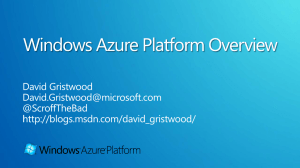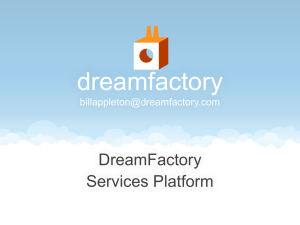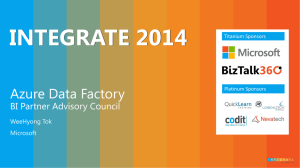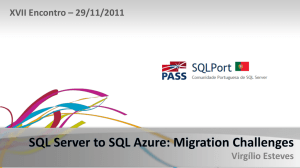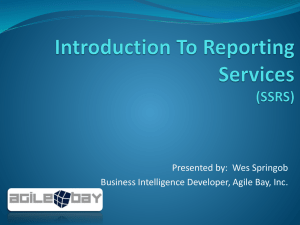Introduction to SQL Azure
advertisement
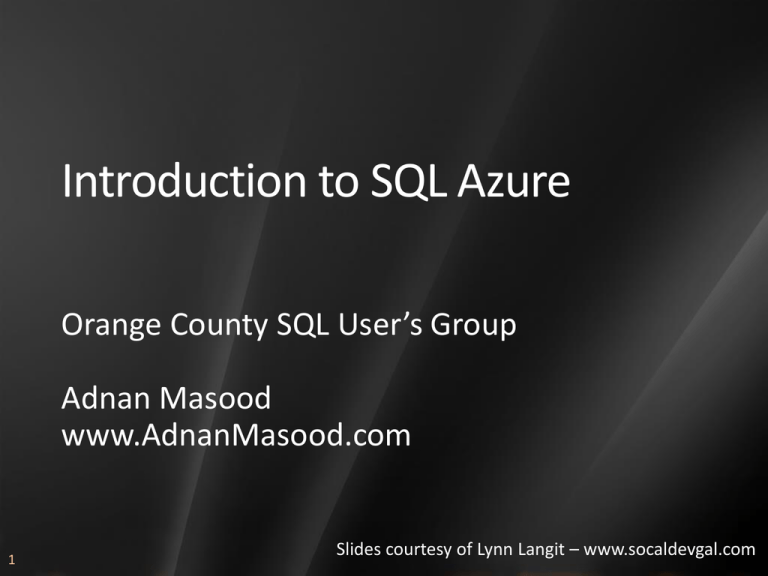
Introduction to SQL Azure Orange County SQL User’s Group Adnan Masood www.AdnanMasood.com 1 Slides courtesy of Lynn Langit – www.socaldevgal.com Windows Azure Platform Compute: Storage: Virtualized compute environment based on Windows Server Durable, scalable, & available storage Management: Database: Automated, model-driven management of the service Relational processing for structured/unstructured data Service Bus: General purpose application bus Access Control: 2 Rules-driven, claims-based access control Extending SQL Data Platform to Cloud Symmetric Programming Model Data Hub Aggregation Initial Services Database – Core SQL Server database capabilities Future Services Data Sync – Enables the sync framework (soon after PDC) Additional SQL Server capabilities available as a service: Business Intelligence and Reporting New services: Reference Data and Secure Data Hub 3 Microsoft SQL Azure Clear Feedback: “I want a database in the Cloud” Familiar SQL Server relational model Uses existing APIs & tools Friction free provisioning and reduced management Built for the Cloud with availability and scale Accessible to all from PHP, Ruby, and Java Focus on combining the best features of SQL Server running at scale with low friction 4 The Evolution of SQL Azure REST Client Application Browser Application REST Client SQL Client* REST Client REST/SOAP + ACE Model OLD SDS HTTP HTTP+REST Windows Azure Data Center Web App Evolves Data Center Windows Azure 5 Application Cloud HTTP HTTP+REST Cloud Browser Application TDS Application REST (Astoria) Web App ADO.Net + EF SQL Client* TDS + TSQL Model SQL Azure * Client access enabled using TDS for ODBC, ADO.Net, OLEDB, PHP-SQL, Ruby, … ODBC, OLEDB, ADO.Net PHP, Ruby, … Database Choices Value Props: Value Props: Roll-your-own HA/DR/scale Dedicated Resources On-premise Value Props: Hosted SQL Azure (RDBMS) Shared Low 6 “Friction”/Control High Scenarios for V1 Departmental Applications Simple application built by individual or department Need simple deployment, self-management, IT: “Empowerment and Governance” Web Applications Small business or startup that uses the cloud as their IT Simple deployment, self-management, scale on demand ISV ISV hosting software on behalf of customer Multi-tenant support for billing and isolation Data Hub (Shortly After V1) Sharing and aggregating of data across tiers and across enterprises Centralized place for data, high scale, sync with existing data sources 7 V1 Application Topologies SQL Azure access from within MS Datacenter SQL Azure access from outside MS Datacenter (Azure compute – ADO.NET) (On-premises – ADO.NET) Application/ Browser SOAP/REST HTTP/S App Code / Tools ADO.NET Data Svcs/REST - EF HTTP/S App Code (ASP.NET) Windows Azure T-SQL (TDS) T-SQL (TDS) SQL Data Services MS Datacenter Code Near 8 SQL Data Services MS Datacenter Code Far Service Provisioning Model Each account has zero or more servers Account Azure wide, provisioned in a common portal Billing instrument Each server has one or more databases Server Contains metadata about the databases and usage Unit of authentication Unit of Geo-location Generated DNS based name Each database has standard SQL objects Database 9 Unit of consistency Unit of multi-tenancy Contains Users, Tables, Views, Indices, etc. Most granular unit of billing Architecture Shared infrastructure at SQL database and below Request routing, security and isolation Scalable HA technology provides the glue Automatic replication and failover Provisioning, metering and billing infrastructure SDS Provisioning (databases, accounts, roles, …, Metering, and Billing Machine 4 SQL Instance User DB1 SQL DB User DB2 User DB3 User DB4 User DB1 Machine 5 Machine 6 SQL Instance SQL Instance SQL DB User DB2 User DB3 User DB4 User DB1 SQL DB User DB2 User DB3 User DB4 Scalability andFailover, Availability:Replication, Fabric, Failover,and Replication, and Load balancing Scalability and Availability: Fabric, Load balancing 10 SQL Azure Deployment Web Portal (API) DB Script 11 SQL Azure TDS SQL Azure Accessing databases Web Portal (API) Your App SQL Azure TDS Change Connection String 12 Database Replicas Replica 1 DB Replica 2 Replica 3 13 Shared Environment A B Hardware Boundary B Hardware Boundary 14 C D Hardware Boundary C C A D A B D Hardware Boundary SQL Azure Database Monitoring & Recovery Web Portal (API) Your App 15 SQL Azure TDS ! Programming Model Small Data Sets Use a single database Same model as on premise SQL Server Large Data Sets and/or Massive Throughput Partition data across many databases Use parallel fan-out queries to fetch the data Application code must be partition aware in v1 For v1 will publish best practices for scale out Post-v1 we are looking at building an abstraction to hide some of the complexities of partitioning Sharding Databases 1 x 10GB database 1 Instances 10 x 1GB databases 10 Instances 17 SQL Tooling & Development 18 Managing your account 19 Viewing database information 20 21 Sample screen – requires VS2010 22 23 Compatibility Goals Support common application patterns Logical/policy based administration Patterns work from SQL Server to SQL Azure Multi-tenancy considerations Throttling and load balancing Limits on DB size, transaction duration, … V1: Address the needs of the majority of web and departmental application 24 Sample of SQL Compatibility In Scope for v1 Tables, indexes and views Stored Procedures Triggers Constraints Table variables, session temp tables (#t) … 25 Out of Scope for v1 Distributed Transactions Distributed Query CLR Service Broker Spatial Physical server or catalog DDL and views Connection Model Use existing client libraries ADO.NET, ODBC, PHP Client libraries pre-installed in Azure roles Support for ASP.NET controls Clients connect directly to a database Cannot hop across DBs (no USE) 26 Logical vs. Physical Administration SQL Azure focus on logical administration Schema creation and management Query optimization Security management (Logins, Users, Roles) Service handles physical management Automatically replicated with HA “out of box” Transparent failover in case of failure Load balancing of data to ensure SLA DBA role places more focus on logical management 27 Deployment Support for basic deployment options SQL scripts work (but not attach database) Geo-location of Windows Azure compute and SQL Azure Databases Support for Application and multi-server management model Support for application packages Cloud or on-premise is a deployment time choice Visibility of data across on-premise and the cloud Support existing and new forms of deployment 28 Security Model Uses regular SQL security model Authenticate logins, map to users and roles Authorize users and roles to SQL objects Limited to standard SQL Auth logins Username + password Future AD Federation, WLID, etc as alternate authentication protocols Security model is 100% compatible with on-premise SQL 29 Pricing Web Edition 1 GB Database $9.99 / month Bandwidth $0.10 /GB inbound $0.15 /GB outbound Business Edition 10GB Database $99.99 / month Bandwidth $0.10 /GB inbound $0.15 /GB outbound Specified by MAXSIZE on CREATE DATABASE command or portal (post-CTP1) Can NOT switch betweenen Web and Business Editions Monthly billing period 30 Platform Readiness (EHA) Exchange Hosted Archive (EHA) is high scale archival service Runs on SQL Azure infrastructure In production prior to SQL Azure v1 Rebuilt to address cost and scale issues http://www.microsoft.com/casestudies/Case_Study_Detail.aspx?CaseStudyID=4000003098 Reduced COGS with increased customer and business benefit: Larger scale (e.g. larger customers ~20TB+ each) More self-managing (e.g. fault-tolerance) 31 Better query performance for fan-out Faster provisioning of new customers SQL Azure Opportunities and Futures Partitioned databases Geo-location and geo-redundancy Distributed query Security w/AD, WLID, etc Support for multiple levels of hardware and software isolation 32 Release Plan MIX ‘09 Mar 09 TechEd Apr 09 May 09 WWPC Jun 09 Internal Adoption Jul 09 PDC Aug 09 SQL Azure Early Adopters Sep 09 Oct 09 SQL Azure CTP SQL Azure Early Adopters CTP – On-board invitation-only early adopters SQL Azure CTP - Register for an invitation code Commercial Availability with Windows Azure in 2009 Sign up for our CTP: http://msdn.microsoft.com/en-us/sqlserver/dataservices/default.aspx 33 Nov 09 Commercial Availability (V1) Key Takeaways SQL Azure available – PDC ’09 Integrated part of the SQL Data Platform Leverage you existing SQL Server knowledge and tools SQL Azure is the data platform of the Windows Azure Platform Want to Know More? Windows Azure Platform http://www.azure.com/ Windows Azure Platform Training Kit http://www.microsoft.com/downloads/details.aspx?FamilyID=4 13E88F8-5966-4A83-B309-53B7B77EDF78&displaylang=en MSDN Development Center http://msdn.microsoft.com/en-us/sqlserver/dataservices Team Blog http://blogs.msdn.com/ssds 35

